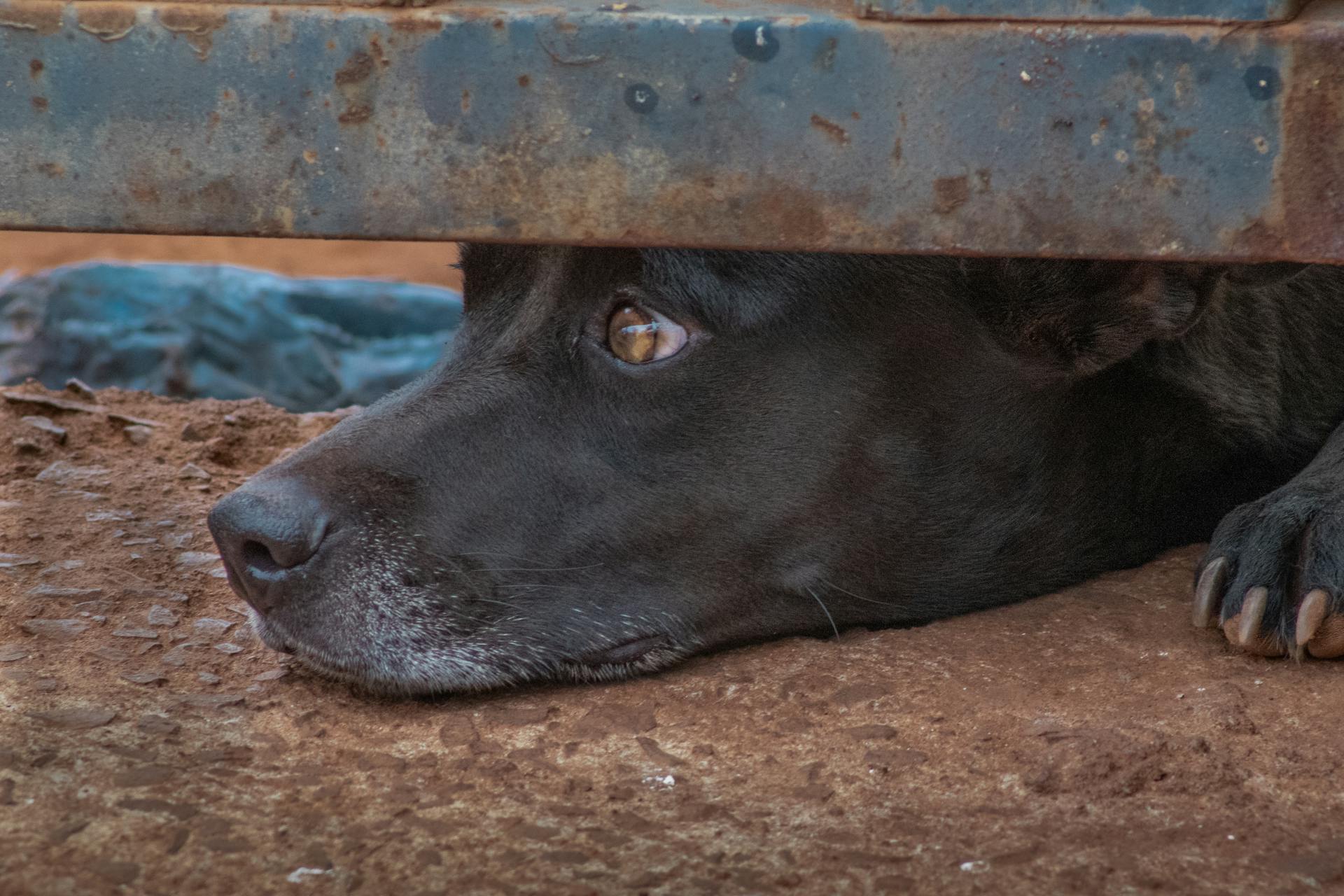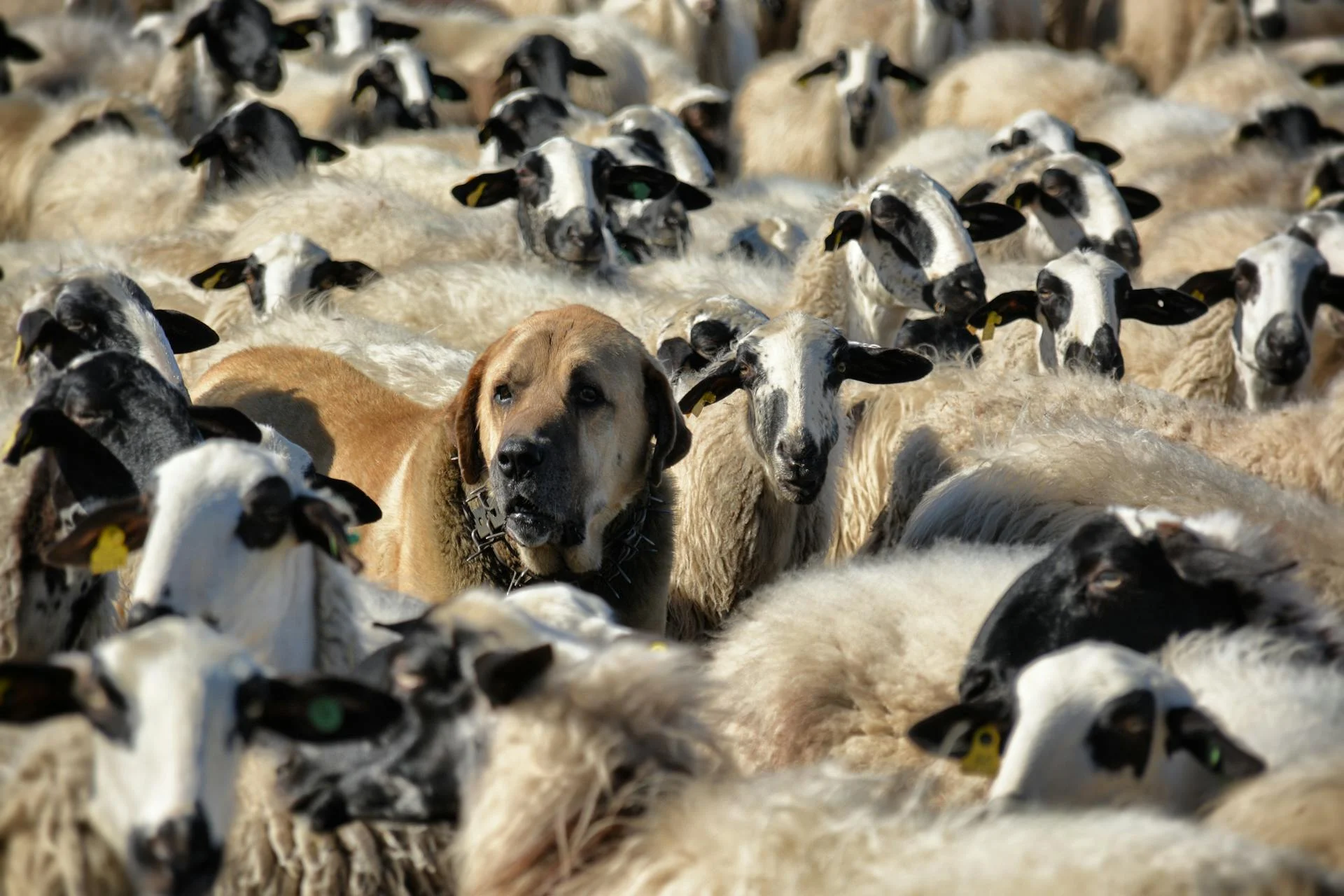
Understanding dog behaviour and body language is crucial to building a strong bond with your furry friend. Dogs communicate primarily through body language, which can be divided into three main categories: relaxation, alertness, and aggression.
Relaxation is characterized by a loose, open posture, with the tail wagging freely. Dogs in a relaxed state often lower their ears and blink slowly.
Dogs use their ears to convey emotions, with forward-pointing ears indicating alertness and sideways-pointing ears indicating fear or anxiety. A tucked tail can be a sign of fear or submission.
A direct stare can be perceived as aggressive, so it's essential to respect a dog's personal space and avoid prolonged eye contact.
You might enjoy: Dog Body Language with Other Dogs
Understanding Canine Emotions
Dogs display emotions on their sleeves, often subtly, and can read our emotions too. This is why it's essential to be aware of our own emotions when interacting with our dogs.
A dog's facial expressions can be misleading, but some are clear indicators of their emotional state. For example, a relaxed dog will have soft eyes, a loose posture, and a wagging tail, while a stressed dog will display hard eyes, a stiff posture, and avoid eye contact.
A relaxed dog's body language is characterized by a loose, waggy posture, with ears held in their natural position, soft eyes, and a neutral forehead. They may also display a relaxed pant or a wagging tail in a wide, sweeping motion.
Some key indicators of a dog's emotional state include:
- Soft eyes: a sign of calm or happiness
- Hard eyes: a sign of a negative state of mind
- Pointed ears: a sign of alertness or stress
- Avoiding eye contact: a sign of discomfort or stress
- Whale eye: a sign of anxiety or stress
By being aware of these signs and responding accordingly, we can build a stronger bond with our dogs and help them feel more comfortable and secure.
Facial Expressions
Dogs don't use their facial features in the same way as people, so it's essential to understand their unique expressions.
Yawning in dogs is a sign of stress, not tiredness or boredom like in people. They use yawning to calm themselves and others, including their owners.
You can try yawning at your dog to provide comfort during stressful moments, like a vet visit. Just be prepared for your dog to yawn back, as yawning is contagious in dogs too.
Lip-licking in dogs can be misinterpreted, but it's not a sign of wanting to lick your face. Instead, it's a sign of anxiety, often accompanied by a quick tongue flick that's easy to miss.
Smiling dogs display their front teeth, but it's not a sign of aggression. In fact, it's often a sign of a happy dog with a loose and wiggly posture, saying "Hello, I come in peace."
Eyes
Dogs often display soft eyes, which have relaxed lids and can appear as if they're squinting, indicating a calm or happy state.
A dog's eyes can also be hard, which means they seem cold and can signal a negative state of mind, possibly due to guarding a toy or feeling aggressive.
Eye contact is a crucial signal for dogs, and a hard stare can be a precursor to aggression.
Looking away is a calming signal for dogs, and it's essential to recognize that avoiding eye contact doesn't mean they're ignoring you or being stubborn.
The whites of a dog's eyes, also known as "whale eye", can signal anxiety or stress in a situation, often seen when they feel uncomfortable or threatened.
Expand your knowledge: Dogs Tail Wagging
Appeasement
Appeasement is a common canine behavior that can be misinterpreted as submission. A dog in an appeasement state will try to appear small and non-threatening.
They might lower their body to the ground or even flip over on their back to expose their stomach. This is a way of saying, "I'm not a threat, I'm harmless."
Their ears will be pinned back, and they'll avoid eye contact, often squinting their eyes. This is a sign that they're feeling anxious or fearful.
You might notice tension around their mouth, and they might pull back their lips to expose their front teeth in an "appeasement grin", which looks like a smile but is actually a way of showing deference.
The dog might also lick around their muzzle frequently. Their tail will be tucked or held low and moving in a slow, tight wag.
A raised front paw can also be an appeasement gesture. Their overall movement will be slow, and their weight will be shifted backward to appear less threatening.
Recommended read: Dogs Ears Back Tail Wagging
What We Need
As we strive to understand canine emotions, it's essential to recognize what our dogs need from us. Patience and self-control are the two greatest gifts that we can help our dogs achieve.
To foster these qualities, we must guide our dogs without micromanaging. This means allowing them to make mistakes and learn from them, rather than correcting them all the time.
Effective communication between humans and dogs is also crucial. By responding to their reactions, movement, and scent, we can help them develop a deeper understanding of our language and behavior.
Here are three key areas to focus on when helping our dogs develop emotional intelligence:
- Patience and self-control
- Improved communication
- Embracing their natural development stages
By acknowledging and respecting these needs, we can build stronger, more trusting relationships with our canine companions.
Relaxed Posture
A relaxed dog is a happy dog, and you can tell by their body language. They tend to have a loose, waggy posture, which is a clear indication of their calm state.
Their ears are held in their natural position, whether that's pointed or floppy. If the dog is active, their ears might be slightly forward.
Their eyes are soft and the forehead is neutral, without any wrinkles. This is a sign that they're feeling relaxed and not stressed.
Their mouth is either closed without tension around the lips or, if they're active, open in a relaxed pant. This is a normal behavior in dogs.
Their tail is wagging in a wide, sweeping motion that's even with the spine. If they're engaged in play, their tail might wag slightly higher.
Some of their movements might be overexaggerated, especially during play. This is just a sign that they're having fun and enjoying themselves.
Here's a quick rundown of the key signs of a relaxed dog:
- Ears: Held in their natural position
- Eyes: Soft and forehead is neutral
- Mouth: Closed without tension or open in a relaxed pant
- Tail: Wagging in a wide, sweeping motion
Aggressive
Aggressive dogs can be a challenge to deal with, but understanding their body language is key to staying safe and calm. A dog showing aggressive body language is ready to react to a stressor.
Explore further: Dominant Dog Body Language with Other Dogs
Their ears will be held differently depending on the reason for the aggression, so it's essential to take their whole body positioning into account. You might notice their ears are up, which can be a sign of aggression.
A dog's eyes will be fixed on the stimulus with a hard, unwavering stare, often accompanied by wrinkles across the forehead. This intense gaze can be intimidating, but it's a sign that the dog is feeling threatened.
Tension around the mouth is a common sign of aggression, often accompanied by wrinkles across the muzzle or a raised upper lip, exposing the teeth. This is a clear warning sign that the dog is feeling stressed.
A stiff-legged "ready" stance, with the dog's weight shifted forward, is a common sign of aggression. The fur might be raised straight up, particularly across the shoulders and at the base of the spine near the tail.
Here are some common signs of aggressive dog body language to look out for:
- Ears up or held back
- Fixed, hard stare
- Tension around the mouth
- Raised fur, particularly across the shoulders and at the base of the spine
- Stiff-legged "ready" stance
If you're concerned about your dog's behaviour, speak to your vet first. They may then refer you to a clinical animal behaviourist.
Identifying Separation Anxiety
Destructive behaviour is a common indicator of separation anxiety in dogs.
If your dog is exhibiting destructive behaviour when you're away, it's likely a sign that they're experiencing separation anxiety.
Unwanted toileting is another telltale sign that your dog may be struggling with separation anxiety.
Reports from neighbours or family members of excessive barking when you're away can also be a red flag.
If you notice any of these behaviours, it's essential to address the issue promptly to prevent it from escalating into more severe problems.
Check this out: Dog Behaviour When Owner Pregnant
Understanding Canine Behavior
Dogs are social animals that live in packs, and their behavior is influenced by their natural instincts.
In the wild, a dog's pack is usually led by an alpha male and female, who establish a hierarchy and rules for the group. This natural behavior is still present in domesticated dogs.
Dogs use body language to communicate with each other, including postures, facial expressions, and scent markings.
For more insights, see: Dogs from Puppy Mills Behavior
A dog's tail can indicate their mood, with a wagging tail usually signifying excitement or friendliness, while a tucked tail may indicate fear or submission.
A dog's ears can also provide clues about their emotional state, with forward ears indicating attention or interest, and ears laid back indicating fear or anxiety.
Tail-Wagging
Tail-wagging is not always a sign of happiness, it's actually a sign of emotional arousal. This means your dog could be feeling excited, frustrated, or even anxious.
The speed of the wag is a good indicator of your dog's emotional state. A fast, twitch-like wag can indicate a higher level of arousal, possibly in a negative way.
The direction of the wag can also hold clues about your dog's emotions. Research has shown that dogs tend to wag their tails more to the right when feeling positive about something, like interacting with their owner.
A helicopter tail wag, where the dog's tail spins in a circle, is almost always a sign of happiness, especially when greeting a beloved person.
Broaden your view: Alternative Food for Dogs
The position of the tail relative to the ground is also important. A high tail can indicate assertiveness, while a tail pointing down to the ground or tucked between the legs can suggest fear and stress.
Getting to know your dog's neutral tail position, which can vary depending on the breed, will help you quickly recognize when their emotions have shifted.
4. Hyperactivity
Dogs can exhibit hyperactivity due to fear and compromised safety, too much or too little exercise, whether physical or mental.
Fear and compromised safety are major contributors to hyperactivity in dogs.
Too much exercise can be just as problematic as too little, leading to an overactive dog.
Helping your dog find their "off switch" can be achieved by ensuring they feel safe, balanced, and happy.
You play a significant role in your dog's emotional state, so it's essential to be calm and confident yourself.
Being calm and confident around your dog will help them feel cool, calm, and collected.
Recall/Lead Pulling
Recall/Lead Pulling is a common issue many dog owners face. It's essential to understand that a lead is a connection, not a correction. Your dog should be connected to you, not to the lead.
To start, practice recall at home, either inside or in the garden. Call your dog and move away in the opposite direction, staying quiet. This will encourage your dog to come over to see what you find interesting.
Crouching and looking down can help your dog focus on you. As they move towards you, call them again and praise or play. This positive reinforcement will help your dog associate coming to you with good things.
Start with short lessons at home and walk backwards, maintaining eye contact with your dog. This will encourage your dog to follow you. Your movement should inspire their movement, making them want to mimic you.
Here's a step-by-step guide to help you practice recall and reduce lead pulling:
- Start at home, inside or in the garden
- Call your dog and move away in the opposite direction
- Stay quiet
- Crouch and look down
- Your dog will come over to see what you find so interesting
- As they move towards you, call them again and praise or play
By following these steps and practicing regularly, you can help your dog learn to recall and reduce lead pulling.
Is Sitting
Sitting is a common canine behavior that can convey a range of emotions and intentions.
If a dog is sitting with its head lowered, ears back, tail tucked away, not making eye contact, yawning, and raising a front paw, it's likely trying to show submission or appeasement.
A lowered head and tucked tail can be a sign of fear or anxiety in dogs, while avoiding eye contact can indicate submission or a lack of confidence.
Should You Use Treats?
Using treats can be a double-edged sword. If used as the only tool to gain a connection, it's at the expense of true connection to you.
Food rewards have their place, especially natural dog treats. Discover 9 benefits of natural dog treats.
If your dog's behavior comes on suddenly, out of the blue, do get a vet check to ensure they are as fit as a fiddle.
Establishing a Good Relationship
Establishing a good relationship with your dog is crucial for their happiness and well-being. By following these simple steps, you can build a strong bond with your furry friend.
Start by finding out how to establish a good relationship with your dog, and you'll be on your way to a lifelong friendship.
Establishing a Good Relationship
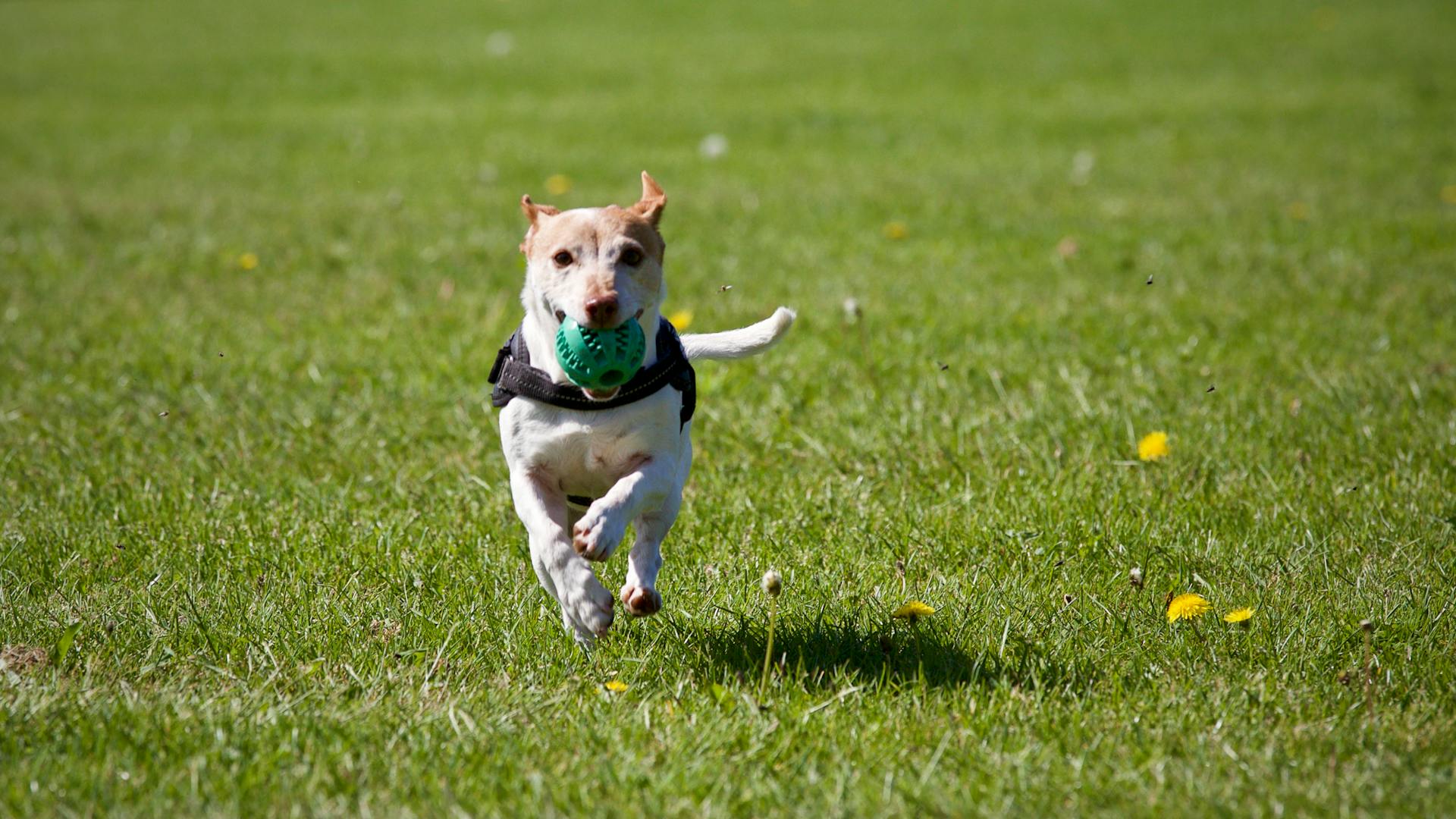
Establishing a good relationship with your dog is crucial for their emotional and psychological well-being. Find out how to establish a good relationship with your dog.
To build trust, spend quality time with your dog, doing activities they enjoy, such as going for walks or playing fetch. This will help them feel more comfortable around you.
Consistency is key when training your dog. Find out how to establish a good relationship with your dog.
How to Help Your Child Become Well-Balanced
Helping your child become well-balanced is crucial for their overall development and happiness. All behaviour, good and not so good, falls within the five areas below, with each area overlapping the next.
It's a flow of conversation; one that has age-appropriate expectations and one that understands what every living being needs. This understanding is key to establishing a good relationship with your child.
Support, safety, understanding, love, and empathy are essential for a well-balanced child. These are the building blocks of a healthy and happy childhood.
Knowing how to calm your child down when life gets too much is just as important as it is for dogs. It's a skill that takes practice, but it's worth it in the long run.
Managing Canine Behavior
Managing Canine Behavior is crucial for a harmonious human-canine relationship. It's essential to understand that dogs are pack animals and often exhibit behaviors that are rooted in their natural instincts.
Dogs communicate primarily through body language, so it's vital to learn how to read their cues. A wagging tail can indicate excitement or friendliness, but a tucked tail can signify fear or anxiety.
Establishing a routine can help reduce anxiety and stress in dogs. A consistent schedule for feeding, exercise, and playtime can provide a sense of security and stability.
Relaxed and Alert States
A relaxed dog is a happy dog! A relaxed dog will have a loose, waggy posture and will be engaged in their surroundings. Their ears will be held in their natural position, either pointed or floppy, and will hang slightly forward.
Here's a quick rundown of what to look for in a relaxed dog:
- Ears: Held in their natural position, pointed or floppy
- Eyes: Soft and forehead is neutral (without wrinkles)
- Mouth: Either closed without tension or open in a relaxed pant
- Tail: Wagging in a wide, sweeping motion or slightly higher during play
An alert dog, on the other hand, is like a dog on high alert, assessing its surroundings for more information. An alert dog's body posture is distributed evenly between the feet in a "ready" position, and they'll have their ears perked up and pointed forward.
Relaxed
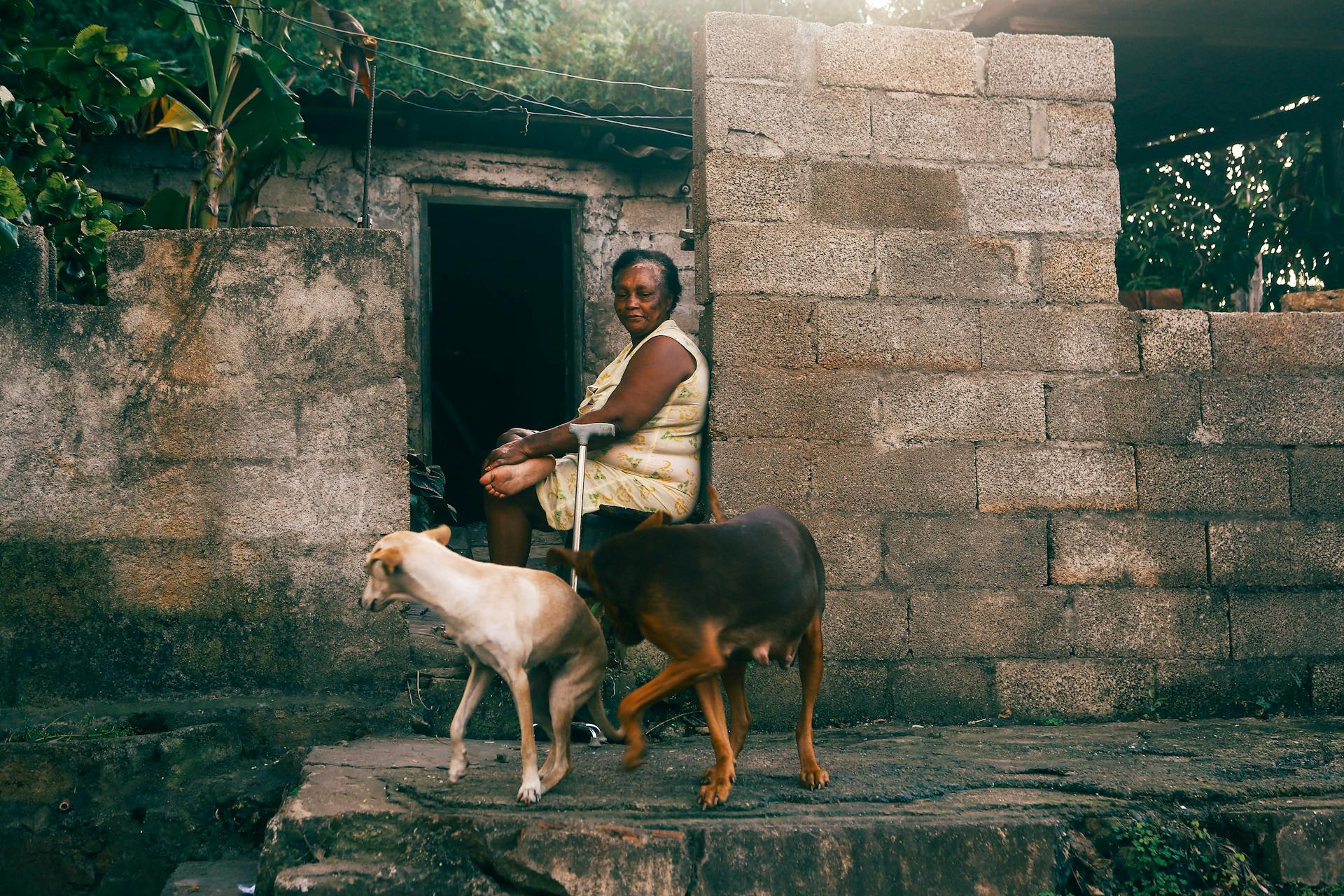
A relaxed dog is a happy dog, and it's easy to spot their calm demeanor. Their body posture is smooth and loose, with their ears in a natural position.
Ears are a great indicator of a dog's mood, and when they're relaxed, they'll hold their ears in a neutral position, whether that's pointed or floppy. Soft eyes and a relaxed mouth are also signs of a happy pup.
A relaxed dog's mouth is either closed without tension or open in a relaxed pant, and their tail is wagging in a wide, sweeping motion that's even with their spine. If they're engaged in play, their tail might wag slightly higher.
Here's a quick rundown of the signs of a relaxed dog:
- Ears: Held in their natural position
- Eyes: Soft and neutral forehead
- Mouth: Closed without tension or open in a relaxed pant
- Tail: Wagging in a wide, sweeping motion or slightly higher during play
Their overall body posture will be soft and wiggly, and some of their movements might be overexaggerated, especially during play.
Alert
Alert dogs display specific body language cues that signal their readiness and focus. Their ears are perked up and pointed forward, even for floppy-ear breeds, where you should look at the base of the ear.
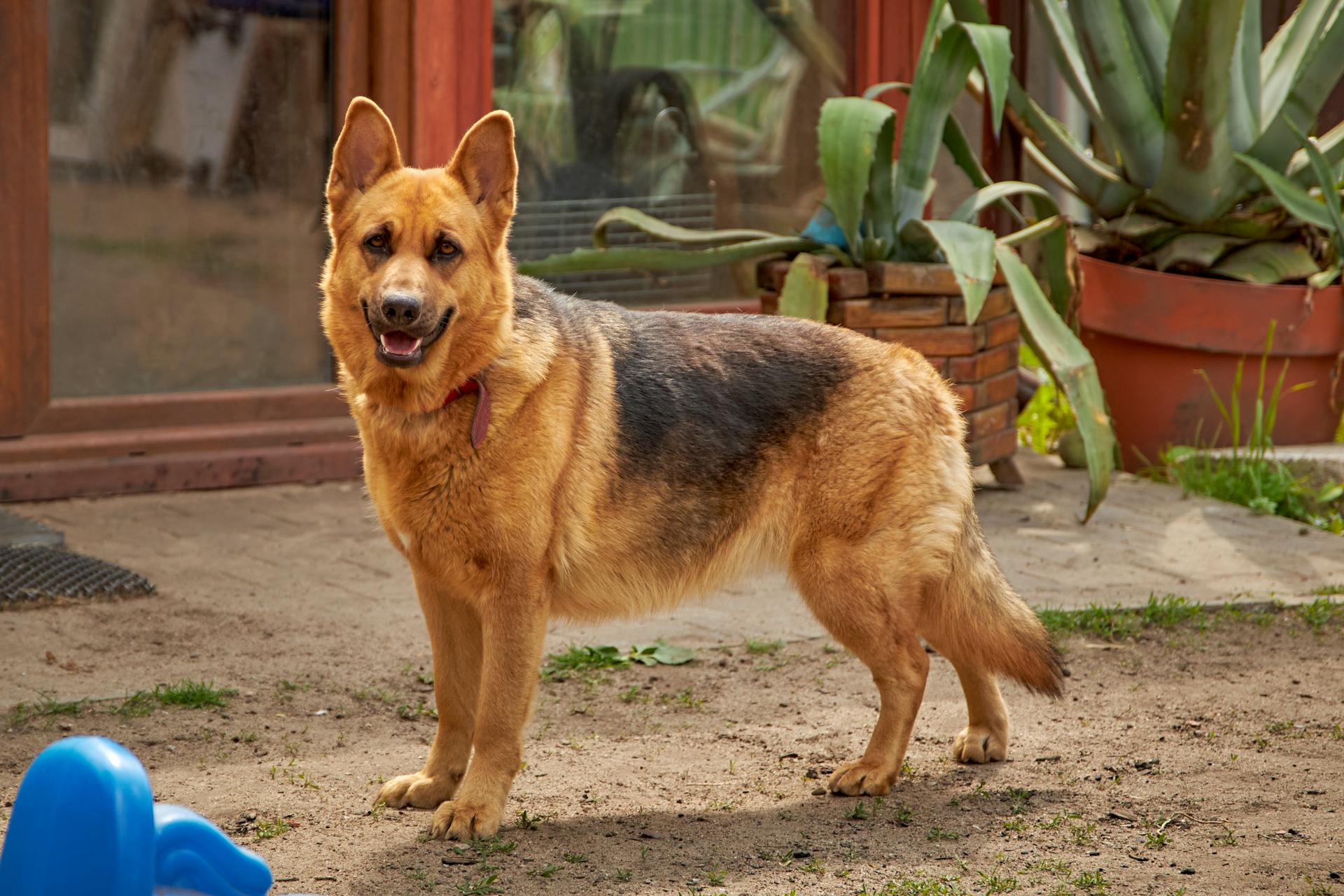
A relaxed forehead is a key indicator of a calm and alert dog, with their eyes wide open and focused. This suggests they're engaged and attentive.
The mouth is closed without any tension at the lips or around the snout, indicating a sense of calm and readiness.
A dog in an alert state will have their tail extended from the body, even with the spine, and possibly wagging slightly. This suggests they're feeling engaged and possibly excited.
The dog's overall body posture is distributed evenly between the feet in a "ready" position, as they determine their next steps.
Stress and Fear
Stress and fear can manifest in dogs in various ways, and it's essential to recognize the signs to provide them with comfort and reassurance.
A stressed or uncomfortable dog may exhibit calming signals such as looking away, turning away, or performing slow movements.
These behaviors are an attempt to self-calm or reduce escalating tension, and it's crucial to respect their boundaries and give them space.
A fearful dog, on the other hand, will often display stiff body language and may hunch over with their back curved and head close to the ground.
Here are some key signs to look out for:
- Ears: Tucked back against the head
- Eyes: The whites of their eyes show (referred to as “whale eyes”) or they angle their eyes toward a stressor
- Mouth: Tightly closed with the corners of the mouth pulled back or excessive panting
- Tail: Tucked up against the belly
Stressed or Nervous
Stressed or nervous dogs often exhibit a range of behaviors that can be subtle or obvious. They might look away or turn away from the trigger, trying to avoid eye contact.
A stressed dog might perform a series of calming signals, which are appeasement or displacement behaviors that help reduce escalating tension. These can include slow movements, yawning, or lip licking.
If a dog is feeling stressed or nervous, they might also exhibit exaggerated behaviors like sneezing or excessive lip licking. They might even shake their bodies as if their coat is wet, or focus on self-grooming.
Some common calming signals include:
- Looking away
- Turning away
- Moving in a curve
- Slow movements
- Yawning
- Freezing
- Lip licking
- Lip smacking
- Sniffing the ground
- Raising one paw
- Scratching
- Shaking off (like after getting wet)
A distressed dog might avoid eye contact or quickly look away when they see the trigger. This can be a sign that they're feeling stressed or uncomfortable.
Fearful
A fearful dog's body language is a clear indicator of their emotional state. They will often display stiff body language, which can make them appear tense and uncomfortable.
If a dog is fearful, they might hunch over, with their back curved and their head close to the ground. Their ears will be tucked back against their head, and their eyes will be angled towards the stressor, showing the whites of their eyes.
A fearful dog's mouth will be tightly closed, with the corners pulled back, or they might begin panting without any change in temperature or activity. Their tail will be tucked in, pressed up against their belly, and they will shift their weight back and away from potential triggers.
The dog's overall body posture will be stiff and low, and they might shed more readily when nervous.
Puppy Behavior and Development
Puppy behavior and development are shaped by how they grow and learn from their environment.
Your puppy develops as a puppy, which has a profound effect on their behavior as an adult. This is where the investment of time and patience really pays off.
How we read the world and our experiences within it have a greater impact on how your dog turns out than training.
Dogs grow and learn by watching us and sensing our emotions, naturally learning using their inner senses. This means they pick up on our moods and reactions, and it's up to us to provide a positive and supportive environment.
To educate your puppy naturally, use the framework of 'The Five To Thrive', which will help bring your puppy up to become a well-balanced adult.
Related reading: Puppy Tail Wag
Seeking Professional Help
If you're concerned about your dog's behaviour, it's essential to seek professional help. Contact a clinical animal behaviourist, as they are behaviour experts who can provide valuable guidance.
They can help you identify the underlying causes of your dog's behaviour and develop a plan to address them. A clinical animal behaviourist will work with you to understand your dog's unique needs and create a tailored approach.
Don't try to tackle your dog's behaviour issues on your own, as this can lead to frustration and potentially harm your relationship with your pet. Contact a behaviour expert to get expert advice and support.
Expand your knowledge: Dog Behaviour Therapists
Frequently Asked Questions
What are 5 abnormal dog behaviours?
Common abnormal dog behaviors include aggression, fear reactions, and repetitive behaviors, as well as signs of pain and distress such as vocalization and hiding. These behaviors can manifest in various ways, including altered facial expressions and postures.
How to read dog psychology?
Reading dog psychology involves recognizing subtle body language cues such as yawning, lip-licking, and furrowed brows to understand canine emotions and intentions. By paying attention to these non-verbal signals, you can better communicate and build trust with your furry friend
How do dogs say "I love you"?
Dogs show affection by leaning into their owners, indicating a desire for closeness and love. This gentle nuzzle is a powerful way for them to express their feelings and seek comfort and security.
Sources
- https://www.akc.org/expert-advice/advice/how-to-read-dog-body-language/
- https://www.bellaandduke.com/learn/dog-behaviour/the-basics/
- https://www.rspca.org.uk/adviceandwelfare/pets/dogs/behaviour/understanding
- https://www.petmd.com/dog/behavior/how-to-read-dog-body-language
- https://caninewelfare.centers.purdue.edu/behavior/canine-body-language/
Featured Images: pexels.com
